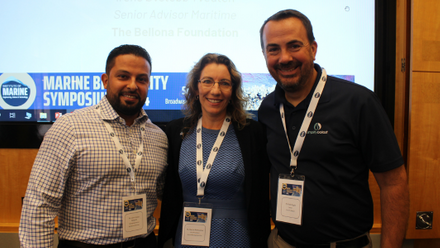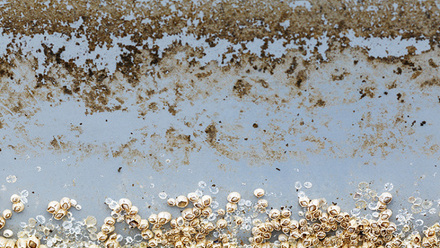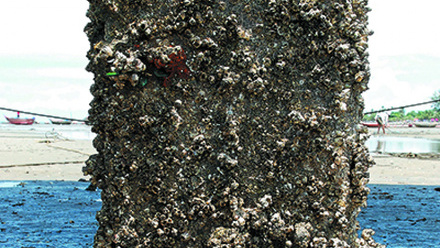Biofouling: tackling the invader outside
Invasive species and organisms attaching to ships’ hulls harm marine biodiversity and affect ships’ performance. Charlie Bartlett considers biofouling costs, emissions and solutions.
The matter of invasive species in ships’ ballast water has by no means been resolved (see this month’s ballast article). But one of the complaints most often levied at IMO is that the Ballast Water Management Convention is an incremental measure and will not tackle all invasive species in one fell swoop.
Sometimes, ‘stowaways’ are found on the surface of ship hulls, too, a problem known as biofouling.
Global effort to tackle biofouling
In March, a five-year initiative began, called the GloFouling Partnerships Project, with the aim of reducing the transfer of invasive species and protecting marine biodiversity by tackling ship biofouling. “Under this new initiative, these industry champions from different sectors are coming together to address common challenges and move towards a more sustainable use of ocean resources,” said IMO Secretary-General Kitack Lim.
Unlike in the case of the ballast water convention, owners stand to benefit from addressing hull fouling, since over time the build-up of organisms ramps up the friction of the hull through the water and increases the workload for ships’ engines.
Changes can make up 10-15% of ship performance in some cases.
However, it is likely to prove a more slippery issue than ballast water as it relies on hull coatings, of which there are a startling array. These are governed by little in the sense of standardisation; and it is hard to know the efficacy of a particular paint or application in shedding invasive organisms.
Unwanted, dead or alive
Next to ballast water, at least the threat from biofouling is more limited, says John Lewis, Co-Chair of the IMarEST Biofouling Management Special Interest Group.
He points out that of the IMO’s ‘Ten of the most unwanted’ list – which includes Cholera, the Cladocera water flea, and the Mitten Crab in the top three – Asian Kelp is the only known marine bio-fouler. Referring to one highly invasive species example, he says: “Zebra Mussels are foulers, but are freshwater and would have crossed the Atlantic in ballast water.
“The fouling species that seems to have the greatest environmental impact... is the Pacific oyster,” Lewis says. “This has been intentionally introduced to many places around the world for aquaculture and is spread along coastlines by domestic vessels.”
Various coatings tackle biofouling in different ways, and while the economics don’t add up in every case, spending a bit more on a coating will generally yield better ship performance, giving owners an incentive to do so.
It is why the coatings field has, for the last decade, become a competitive battleground, with no one, obvious solution.
It’ll polish out
“Biofouling obviously has a significant and well-understood effect on ship performance,” says John Drew, Director, Nippon Paint Marine (Europe) GmbH. His company has two solutions: one is a biocide-free coating, Aquaterras, an “SPC (self-polishing copolymer) which uses micro-domain material originally used in the pharmaceutical industry to prevent blood clotting in artificial hearts and blood vessels.”
For this type of coating, loss of paint particles – polishing – is necessary to create a moving target which stops the build-up of green slime, a pre-requisite for more aggressive types of fouling.
“Biocides such as copper or cuprous oxide are often comparatively rough,” Drew explains. However, “as no heavy biocidal pigments are contained in the paint, Aquaterras’ finished surface and appearance can be ultra-smooth which, when combined with excellent anti-fouling performance, leads to fuel and emissions savings.”
Hopefully, vessels with these coatings will stay on the move, Lewis indicates. “Biocide-free foul release coatings work exceptionally well on active, higher-speed vessels such as cruise ships, container ships, and high-speed ferries, without the need for cleaning, but foul during periods when idle,” he says. “This accumulated fouling is then not dislodged when the vessel resumes service. Only very soft cleaning methods can be used on FR coatings, as these rubbery coatings are very prone to abrasion.
“There is a new FR coating that contains a low concentration of biocide to prevent fouling when static, which is showing good performance overall.”
Nippon Paint also has a biocide coating, A-LF-Sea, which slowly leaks copper silyl-acrylate to kill organisms on the hull. “A-LF-Sea (Advanced Low-Friction systems)... [has] been applied on thousands of the world’s most important ships and not only have they demonstrated excellent, long anti-fouling performance, but thanks to the low-friction effect of the hydro-gel incorporated they have helped to reduce emissions and operators’ fuel consumption,” Drew says.
New generation biocides
In recent years manufacturers of biocide coatings have cleaned up their act, Lewis notes.
“Anti-fouling biocides are toxic by nature, but with the banning of tributyl-tin (TBT), the likely banning of cybutryne, and historic banning of arsenic, mercury and lead compounds, the worst have gone,” he says.
“The most common biocides in use today are copper compounds, as they have been for the last century and a half, and the risk of these is often exaggerated. Copper loses its toxicity within less than a millimetre of the paint surface.
“Of the new co-biocides, these have passed high scrutiny in regard to environmental persistence and toxicity. My personal opinion is that modern anti-fouling coatings cause little harm, and the environmental impact of not using these would be far greater through increased fuel use and consequent GHG (Greenhouse Gas) emissions caused by even low levels of biofouling on hulls.”
Get scrubbing
A third type of coating involves the combination of a hard coating – one with no biocides, gels, or potential for polishing – and intervals of hull-cleaning.
In 2017, Jotun came up with HullSkater, an interesting technique for hull cleaning using a kind of remote-controlled, hull-scrubbing Roomba.
“High-powered magnets attach the unit to the hull, allowing it to perform underwater inspections and proactive cleaning using HD cameras,” says Geir Axel Oftedahl, Jotun’s Business Development Director (Marine).
The HullSkater device can be carried on board the ship and deployed and retrieved by the crew. From there, it is remote-controlled by Jotun themselves. “We can operate HullSkater units all over the world from our control centre here in Norway, day and night,” says Oftedahl. “We learned that depending on the size of the vessel, cleaning and inspection can take between 2-8 hours.”
Wallenius Wilhelmsen, has been testing the system for several years as part of a pilot programme. It delivered a positive verdict earlier this year.
“By removing slime and fouling before organisms have time to firmly attach to the hull, HullSkater... helps vessels stay in compliance with increasingly strict local and global regulations designed to protect marine ecosystems from alien invasive species,” says Wallenius Wilhelmsen SVP Marine Operations Geir Fagerheim.
However, “hard, biocide-free, scrubbable coatings will foul readily between cleans, and would require regular cleaning in all but the coldest coastal waters.
Fouling is insignificant in the open ocean,” Lewis says. “My personal view is that the best biofouling management is by using the modern self-polishing copolymer coatings with copper oxide and one of three newer co-biocides. [But these] are extremely expensive, which restricts take-up.”
He concludes, “these coatings are needed to reduce the environmental impact of fuel-related emissions. Regular hull grooming to remove the slime that forms on all coatings would also help to improve efficiency.”

Charlie Bartlett is a maritime journalist.






